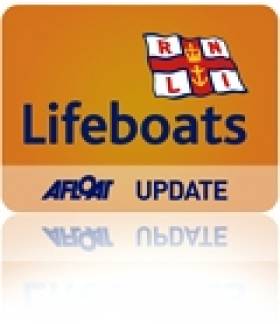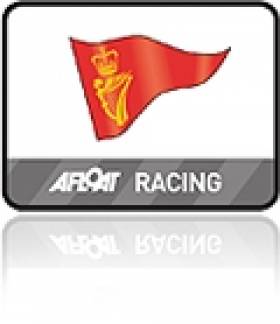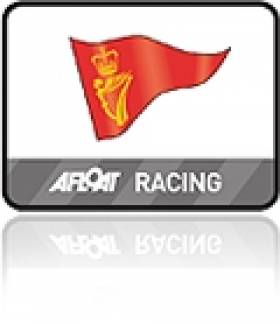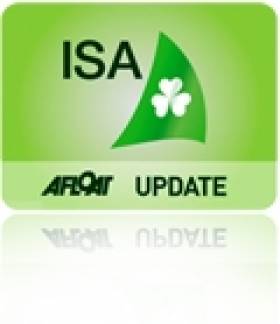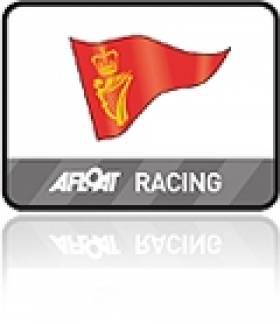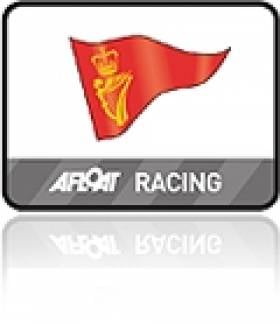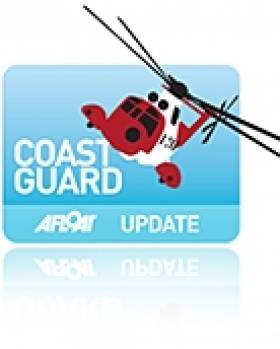Displaying items by tag: Crosshaven
Laura and Sam Say Thank You RNLI Crosshaven
In April of last year, Laura was walking her dog near Hop Island, when he ran out over the mud flats and got stuck in the mud. Laura went after him and eventually got bogged down herself. Her predicament was fortunately noticed from the shore line and the volunteer RNLI lifeboat from Crosshaven was tasked along with the Coast Guard helicopter, the fire service and local Coast Guard units to attend.
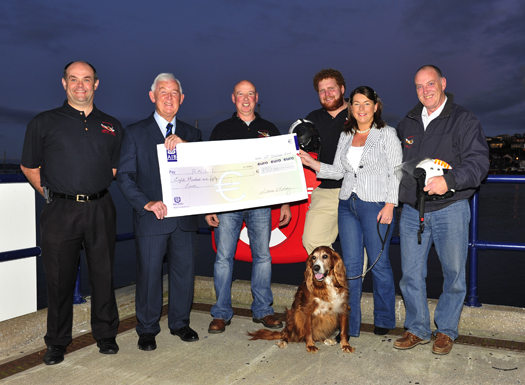
Bernard Lynch, Barry Woods, Chairman, Crosshaven RNLI, Vincent Fleming, Denis Cronin, Laura O'Mahony and Alan Barton, Lifeboat Operations Manager, Crosshaven RNLI and SAM
Volunteers Vincent Fleming, Denis Cronin and Bernard Lynch made best time to the area as the rising tide was filling rapidly. Crewman Fleming managed to thread the lifeboat through the flats until he got near to Laura, at which point Bernard Lynch entered the water and extricated Laura and 11 year old Sam into the lifeboat. Laura was then handed over to the care of paramedics at the shore. Thankfully, Laura and Sam were uninjured.
Laura remarked, "I never thought I'd have to use the services of the lifeboat but I am most grateful to them. They are so hard working and lovely, and were so kind when they rescued us. When I saw them I knew we were safe. They kept on reassuring me."
In the intervening period, Laura has raised €850 for the RNLI, and on Wednesday last visited the Lifeboat station with Sam to hand over the proceeds and personally thank the crew. She said "This cheque is just a small way of saying thank you,"
'Gloves off' Onboard Vid from Royal Cork Regatta
Brian Carlin was sailing onboard the Twomey's Corby 38 'Gloves Off' yesterday in the second outing of Royal Cork's Autumn regatta. The October event has attracted over a hundred entries and it is sponsored by O'Flynn Exhams Solicitors. His clip below features onboard action from the class one competitor plus lots of 1720 sportsboats, broaching in the gusty harbour conditions.
Main regatta report and photos from Bob and Claire Bateman here.
Big Breeze for Second Race of Royal Cork Autumn Regatta
Strong westerlies that swept Royal Cork's Yacht Club's George Kenefick to success at the All Ireland championships on Lough Derg also blew for the second race of his club's Autumn regatta in Cork Harbour today writes Claire Bateman. Bob Bateman's action photos are below.
It was a day that kept the best wine until last. There was much sailing activity in the harbour with some seventy five cruisers sailing their various courses and some ninety dinghies from Optimists to Laser 4.7s sailing in a strong westerly breeze with warm overtones . Although the wind was there all day, and plenty of it, when the sun broke through in the early afternoon it created that special Cork Harbour sailing ambience.
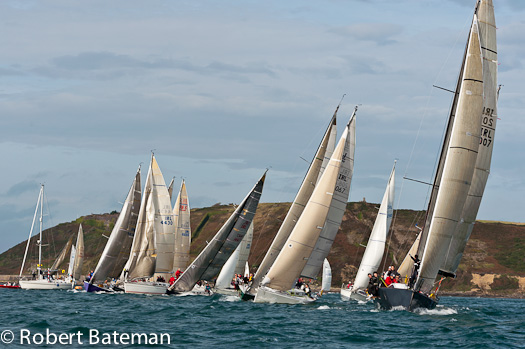
A great start for the Autumn fleet. Photo: Bob Bateman. More pics below
Classes Three, Four, and Whitesail 1 and 2 sailed on the Eastern Bank with Race Officer Richard Leonard and he started with a triangle course followed by a windward/leeward course. There was plenty of excitement on this course with mention of Chinese gybes. The Dorgan Sonar from Cove Sailing Club revelled in the conditions and got the better of Ian Travers' Bandit from Kinsale (currently for sale on the Afloat boats for sale site here) while Michael Murphy's Shelly D had won the day in ECHO with Alan Mulcahy's Sundancer from Kinsale taking IRC.
Meanwhile on the Red Course with Race Officer David O'Brien it was a perfect day for the 1720s and fleets 1 and 2. Your scribe was watching the second race that started inside the harbour just inside Roches Point on a beat in a strong flood tide to W2, a screaming reach to Harp, a beat back to W2, back to W1 before a number of dramatically tight finishes near the Cage. The 1720s displayed the best of One Design racing as they came into W2 with one boat becoming the meat in the sandwich between the buoy and the fleet with no quarter being given and had to do their penalty turn. In the best 1720 tradition, despite the high, wind they hoisted their kites as they went hither and thither before most got sense and finally dropped their kites.
On the day it was Denis Murphy's Aquatack from the home club took the honours followed Peter O'Flynn's Two 2 Tango.At the time of prizegiving Class 2 were still involved with protests but first again this week on IRC was Brian Goggin's Allure (KYC) followed by the Desmond/Deasy/Ivers Bad Company from the home club. In Class Zero IRC in a reversal of last week's results Kieran and Brian Twomeys' Gloves Off got the better of Conor Phelan's Jump Juice on the day. In Class 1 IRC David Scott's EOS again took the spoils but Dan Buckley's Justus was going very well and took the second slot.
As Rear Admiral Cruisers Ronan Enright had promised, the prizegiving was bang on 5.30pm with the prizes being presented by Frank O'Flynn of the Sponsor Company who incidentally had been sailing on the Peter O'Flynn Two 2 Tango 1720.
Racing continues in the O'Flynn Exhams sponsored league next Sunday with a first gun at 11.55am.
O'Leary Not Defending 'All Ireland' Title
The only hat-trick winner of the Irish Sailing Association's (ISA) All Ireland Sailing Championships, Royal Cork's Nicholas O'Leary will not be defending the title when the 2011 event is sailed in two weeks time. Names of the 16 invitees, drawn from dinghy and keelboat classes, were published today. Among those attending is O'Leary's father Anthony representing Cruiser Class Zero and his Crosshaven club mate, the 2011 1720 National Champion Mark Mansfield, a past winner of the event.
Nicholas O'Leary is one of 12 invitees – either national champions or top ranked sailors – who are unavailable to attend. Only 16 of 28 invitees had accepted the invitation by last week's entry deadline.
The Waterways Ireland sponsored event takes place at Lough Derg Yacht Club which was originally scheduled for three days but is now running on the 8th and 9th of October only. The event is raced in J80's.
The 16 invitees are as follows:
|
Name |
Club |
Class |
|
Adrian Allen |
Ballyholme Yacht Club |
Multihull |
|
Roger Bannon |
National Yacht Club |
Mermaid |
|
Noel Butler |
ISA |
Fireball |
|
Alan Claffey |
Royal St. George Yacht Club |
Ruffian |
|
Ben Duncan |
Howth Yacht Club |
Laser SB3 |
|
Brian Goggin |
Kinsale Yacht Club |
ICRA '2' |
|
David Gorman |
National Yacht Club |
Flying Fifteen |
|
Alan Henry |
Sutton Dinghy Club |
IDRA 14 |
|
George Kenefick |
Royal Cork Yacht Club |
ICRA '3' |
|
Mark Mansfield |
Royal Cork Yacht Club |
1720 |
|
John McGuinness |
Moville Sailing Club |
GP14 |
|
Flor O'Driscoll |
Howth Yacht Club |
J24 |
|
Anthony O'Leary |
Royal Cork Yacht Club |
ICRA '0' |
|
Pat O'Neill |
Clontarf Yacht & Boat Club |
E-Boat |
|
Gordon Patterson |
Royal North Yacht Club |
Squib |
|
Ryan Seaton |
Ballyholme Yacht Club |
Olympic 49er |
Cork Week 2012 Chairman Appointed
Royal Cork Yacht Club has announced Pat Lyons will chair the club's biggest sailing regatta next season. Cork Week 2012 at Crosshaven is scheduled to run from the 7th - Friday 13th July 2012 following a decison to move the date back a week to avoid a clash with the Solent's Round the Island Race. Lyons has served on Royal Cork's Club Executive for the last 4 years.
O'Leary Stays in Top Ten in New York
Anthony O'Leary's Royal Cork Yacht Club crew stay in the top ten overall after scoring two double digit results yesterday at the Rolex New York Invitational Cup. The Crosshaven crew counted a 20 and a 15 in the 22-boat fleet.
After several days of late summer breeze and sunshine, thick fog rolled into Narragansett Bay, greeting competitors of the New York Yacht Club Invitational Cup presented by Rolex and forcing a short postponement to today's racing. Twenty-two yacht club teams from 16 countries are here in Newport to contest the second edition of this biennial event.After a delay of just under an hour, the fleet were sent up Narragansett Bay, north of the Newport Bridge where the flat water and 10-knot south-southwesterly built to a perfect 12-15 knots by the afternoon.
Yesterday after six races were completed, the Royal Canadian Yacht Club team, skippered by Olympic silver medalist Terry McLaughlin, had a solid lock on the top of the leader board with a 13-point advantage over the New York Yacht Club team.
But with a fleet this deep in talent, one bad race and a double-digit advantage can be whittled down. As McLaughlin presciently said yesterday, "That can disappear in a real hurry." Meanwhile the NYYC team, led by Ken Colburn with Phil Lotz, the 2009 Invitational Cup winner, as tactician kept their focus with fourth and second place finishes today and closed the gap with Canada to five points.
While Lotz' recap of their races sounded pretty matter-of-fact, the American team worked hard to get a good start on the right side and found a lane there that enabled them to tack when they wanted. Lotz said, "We were lucky enough that the right paid off and we kept our nose clean and got around the course. We were fortunate enough to get to the right side early." But with three more races planned, he was quick to add, "I think with a shifty nor'west tomorrow, it's anybody's game. Bad races are just as possible as good races. If it's more breeze and shifty, it's going to be a boat handling issue, and keeping your head out of the boat and seeing where the shifts are, and making sure you're going in the right direction."
Newport Harbor Yacht Club edged past Annapolis Yacht Club today to stand in third place overall.
The group of teams with first place finishes grew today with eight unique winners over the same number of races. Two boats that had barely cracked a top ten finish prevailed today: the German team from Norddeutscher Regatta Verein and Clube Naval de Cascais from Portugal.
For Patrick de Barros' Portuguese team, it all came together on the last race where they got off the start line well-positioned, rounded the weather mark in third, and then went to the left side of the course where they got in front and held their lead. Although NYYC team threatened, CN de Cascais covered them very closely at the finish and crossed ahead. Clearly buoyed by their performance de Barros said, "We have the speed, now we start to know how the boat functions. It's a very challenging course, a good course, but challenging. It's been really fantastic, we've enjoyed every minute."
The Royal Yacht Squadron enjoyed a good bump up the standings going from 11th to seventh. Helmsman Glyn Williams explained, "I was a little disappointed after yesterday's sailing, as I didn't feel we sailed to the potential. The team had done a lot of sailing together and we were just making unforced errors early in the week. So our first race today, we got cleanly off the line. At the top mark, we did a gybe set, which was incredibly clean and put us in the hunt. I told the team this morning that yesterday Annapolis moved from tenth to third, so there're options to go up in a series like this. The crew did a great job today!"
Oliver Stanley, RYS team captain, spoke of the competition, "I think the standard of sailing is as high as you get in any amateur regatta, anywhere in the world. It's a great privilege to be here -- make one mistake and you lose six places."
Stanley was with the team at the 2009 Invitational Cup event, when the RYS finished in 16th place overall. He recalled, "Given our finish, we weren't invited back on merit. We were invited on ancestry, history and tradition. It's very important that we're invited back on merit this time. We really want to be automatically invited, to have a top five finish. We'd be over the moon with that."
Racing continues tomorrow Friday through Saturday 16 - 17 September. Tomorrow's first warning signal is scheduled for 11:00 am.
Results after 8 races:
Team - Country - Points
1. Royal Canadian, CAN, 29
2. New York, USA, 34
3. Newport Harbor, USA, 61
4. Annapolis, USA, 63
5. Royal Hong Kong, HKG, 70
6. Eastern, USA, 76
7. Royal Yacht Squadron, GBR, 77
8. Japan, JPN, 80
9. Royal Cork, IRL, 86
10. YC Argentino, ARG, 89
11. Royal Ocean Racing Club, GBR, 91
12. CYC Australia, AUS, 95
13. NRV, GER, 99
14. Royal Norwegian, NOR, 102
15. Royal Cape, RSA, 104
16. CN de Cascais, POR, 106
17. Royal Bermuda, BER, 106
18. NJK, FIN, 112
19. Itchenor, GBR, 116
20. YC Capri, ITA, 123
21. RCN Barcelona, ESP, 148
22. YC Punta Ala, ITA, 160
The 22 entrants
By country, the roster of participating teams is: Yacht Club Argentino (ARG); Cruising Yacht Club of Australia (AUS); Royal Bermuda Yacht Club (BER); Royal Canadian Yacht Club (CAN); Royal Hong Kong Yacht Club (HKG); Real Club Nautico de Barcelona (ESP); Nyländska Jaktklubben (FIN); Itchenor Sailing Club, Royal Ocean Racing Club and Royal Yacht Squadron (GBR); Norddeutscher Regatta Verein (GER); Royal Cork Yacht Club (IRL); Yacht Club Capri and Yacht Club Punta Ala (ITA); Japan Sailing Federation (JPN); Royal Norwegian Yacht Club (NOR); Clube Naval de Cascais (POR); Royal Cape Yacht Club (RSA); Eastern Yacht Club, Annapolis Yacht Club, Newport Harbor Yacht Club and New York Yacht Club (USA).
RS 200: the 'ideal' next step for Irish Youth Sailing?
Questions over the next step for juniors after the RS Feva point to the bigger RS200 writes Feva sailor Ciara Byrne
The RSFeva has become the world's best selling two-person dinghy in recent years with fleets also growing in clubs all over Ireland. It is fast becoming the most popular and widespread choice for teenagers and youth sailors who enjoy competitive, active and exciting sailing.
However many questions were being asked recently at the RSFeva Nationals, held in Crosshaven, Co. Cork, regarding the next step for young, talented sailors who wish to continue racing in large fleets without the difficult transition of transferring from the Feva into a larger, unfamiliar dinghy. This uncertainty has led to many sailors dropping out of sailing altogether, while the remainder have split the fleet into Lasers, the 420/470 or moved on to cruisers.
However these dinghies require a lot of time and effort of getting used to, leaving some sailors frustrated and also, less motivated. To avoid this altogether, there is one simple solution: the RS200.
The RS200 is a spacious, one-design, double-handed, hiking, high-performance dinghy which has developed a huge following at club, circuit and championship level in the UK with a growing fleet in Ireland. A pivoting centreboard and rudder allow easy launch and recovery with a thwart giving the crew a comfortable position for light winds. With the asymmetric spinnaker, similar rigging and a similar design, it can be considered as a larger and faster Feva which makes for an easy changeover and the most logical and simple step up.
The ideal weight for an RS200 is 115-145kg (18-23 stone) which allows people of all ages to sail and race effectively in this dinghy. Ideal for teenagers emerging from the Feva, parents, youths, couples, friends and relatives can also come together which enhances the family and social scene.
Even though the 420 has a larger total sail area, the RS200's asymmetric spinnaker of over eight square metres, with a smoother single line hoist and drop system, similar to the Feva's. makes for a faster boat and requires greater tactical and more exciting downwind sailing. This encourages competitive racing and enhanced racing skills.

An RS200 at full speed off Greystones. Photo: Fiachra Etchingham
A maintenance free hull, made of lightweight polyester GRP ensures a long competitive life and second hand boats can be in very good condition so that older hulls are without the disadvantage experienced in fleets such as the 420. Furthermore, every hull comes from the same manufacturer giving no subtle advantage to any one boat; therefore racing just comes down to the sailors' tactics, boat handling and general knowledge of sailing and racing.
While the RS200 is not an Olympic class, there are large UK and Irish fleets which are active and competitive. Johnathan Lewis, a UK Feva coach and RS200 sailor, strongly encourages Feva graduates to move into the RS200 as it is an easy transition and makes for fun and exciting sailing. RS200 fleets are strong in Irish clubs such as those in Northern Ireland including Ballyholme, Newcastle and Cushendall as well as Greystones Sailing Club in Co. Wicklow.
Greystones Sailing Club boasts probably the largest asymmetric dinghy fleet in Ireland with fifty five asymmetric dinghies, twenty one of those being RSFevas and the majority of the remainder being RS200s. Recognising the RS200 as the natural progression from the Feva, ages range from fifteen to fifty five across the RS200 and RS400 fleets in the Club, with most of these boats competing in national events in Ireland, and some in the UK and further afield.

Rounding a mark in the RS200. Photo: Fiachra Etchingham
As fleets build in Dún Laoghaire and Howth yacht clubs, the RS200 is gradually becoming a popular progression from the Feva, and with the RS400 as a follow on boat for larger crews, young sailors can remain involved and spirited in asymmetric racing. The RS200 satisfies a thirst for speed and pace which generates more exciting, competitive and enjoyable sailing for those emerging from Feva fleet.
A Dublin Sailor (who has asked not to be named) has sent us comments on this story:
As one involved in junior and youth sailing at club level, one of the big decisions that faces youths is where to go after junior classes such as Optimists, Toppers, Fevas. Like any other sport, there is a high attrition rate after the age of 14 / 15, especially among girls which is an even greater shame as they can compete on a par with the guys.We need a class that will keep youths engaged. The 420 & 29er are great boats but require higher levels of boathandling, are much more competitive and tend to attract the top sailors. They also suffer from an inability to match up crews who will stick together - teenagers chop and change all the time and its difficult to race a boat like a 420 / Fireball / 29er wihout a constant crew partnership.
We need a boat/class that:
- Enables swapping around of crews without a major impact on the boathandling / teamwork. A sailor's plans for the weekend / event / season are not scuppered because of crewing issues.
- Does not need a highly competent crew (e.g. ability to trapeze and fly / gybe a kite etc.) so that sailors can sail with their mates who may not necessarily be top-notch sailors but who can acquit themselves well in a slightly less complex boat.
- Has a good mixed social scene which is the most important element of any class, youth or otherwise.
- Does not cost the earth in terms of purchase price, is easy on wear & tear on kit (hence replacement & upgrade costs) or does not go soft and become uncompetitive needing a new hull after three to five years etc
- Has international competition that is closeby (UK, FR, Bel, Ned etc) for those aspiring to a bit more
- Has a motiviated class structure to help grow the class.
The fear is that we are starting out another class that will dilute the current youth class efforts. However I believe that the 420 and 29er will hold their own and continue to attract top sailors with ISAF ambitions.
On the other hand, if we continue to support these we will continue to lose the middle ground (and majority) of young sailors from our sport. Youths are fickle enough and if its too much hassle to deal with all the challenges of getting afloat they just won't bother - sad but true.
The ISA needs to take a lead in this and while its Olympic ambitions are great to see, it will fail the sport as a whole if it does not tackle this gaping need in its portfolio of support.
I believe that the RS200 and R2400 provide the best solution to these challenges. They appear well-built and the manufacturer certainly appears well organised and gets involved.
Looking from outside and without any vested interests (other than the health of junior and youth sailing) the RS's get my vote as a class that can make a radical difference.
Royal Cork Celebrates 2011 with 'At Home' Regatta
Royal Cork Yacht Club Admiral Paddy McGlade presided over the Crosshaven Club's annual 'At Home' Regatta yesterday, an event dedicated to families with entertainment this year from the Carrigaline Pipe Band. Among a number of fun events such as Tug 'o' war, the highlight was the intense competition on the water for the Optimist parents race. All the action on the Afloat gallery by Bob Bateman here.
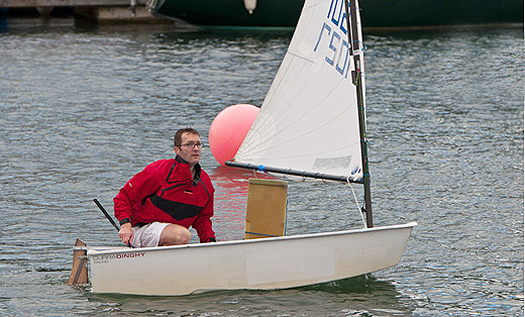
Royal Cork's Patrick Coveney in calm seas for the 'At Home' Optimist race
Cork Week Changes Dates for 2012
Next year's Cork Week regatta at Royal Cork Yacht Club, one of Ireland's biggest sailing events, has changed dates from 30th June – Friday 6th July to 7th-13th July 2012 following consultation with both local and overseas participants.
The decision was made to change the date of the biennial event because it would have otherwise have clashed with Britain's Round the Island Race on June 30th.
'Following continuing contact with the OPW, it has been confirmed to me that a new contract for the construction of the new station has been awarded and work is to start very soon. This tender process has been ongoing for more than a year and I am delighted that it has finally been awarded and work to commence shortly.'

Marine Minister Simon Coveney TD with Victor Shine Deputy Area Officer Crosshaven Coast Guard Unit, Vincent Farr Area Officer and James Furlong Unit Member looking over the plans for the new €1.5 Million Coast Guard Station at Crosshaven, Co. Cork. The contract has been awarded to Blarney firm Cumnor Constuction Ltd and work will commence shortly. Photos Billy macGill
'Those who work at Crosshaven Coast Guard are to be commended for their commitment and dedication to the local community in a voluntary capacity. We must now ensure that they are working in a station that reflect this loyalty and high standard of service.'

The contract has been awarded to Cumnor Construction Ltd. of Blarney on August 3rd. Work on the site is expected to commence very shortly.




























